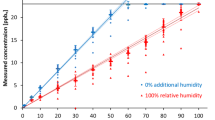Abstract
Objective. Medical mass spectrometers are configured to detect and measure specific respiratory and anesthetic gases. Unrecognized gases entering these systems may cause erroneous readings. We determined how the Advantage 1100 (Perkin-Elmer, now Marquette Gas Systems, Milwaukee, WI) and PPG-SARA (PPG Biomedical Systems, Lenexa, KS) systems that were not configured to measure desflurane or sevoflurane respond to increasing concentrations of these new potent volatile anesthetic agents.Methods. Desflurane 0% to 18% in 3% increments or sevoflurane 0% to 7% in 1% increments in 5-L/min oxygen was delivered to the Advantage and PPG-SARA mass spectrometry systems. For each concentration of each agent, the displayed gas analysis readings and uncompensated collector plate voltages were recorded.Results. The Advantage 1100 system read both desflurane and sevoflurane mainly as enflurane and, to a lesser extent, as carbon dioxide and isoflurane. For enflurane(E) readings <9.9%, the approximate relationships are: %Desflurane=1.6E; %Sevoflurane=0.3E. These formulas do not apply if E >9.9% because of saturation of the summation bus. PPG-SARA read desflurane mainly as isoflurane(I) and, to a lesser extent, as nitrous oxide. PPG-SARA read sevoflurane mainly as enflurane(E) and, to a lesser extent, as nitrous oxide and halothane. The approximate relationships are: %Desflurane=1.11 (for I < 9%); %Sevoflurane=2.1E.Conclusions. Advantage 1100 and PPG-SARA systems not configured for desflurane or sevoflurane display erroneous anesthetic agent readings when these new agents are sampled. Advantage 1100 also displays falsely elevated carbon dioxide readings when desflurane is sampled.
Similar content being viewed by others
References
Eisenkraft JB, Raemer DB. Monitoring gases in the anesthesia delivery system. In: Ehrenwerth J, Eisenkraft JB, eds. Anesthesia equipment: Principles and applications. St Louis: Mosby-Year Book, 1993:201–220
Elliott WR, Raemer DB, Goldman DB, Philip JH. The effect of bronchodilator-inhaler aerosol propellants on respiratory gas monitors. J Clin Monit 1991;7:175–180
Kharasch ED, Sivarajan M. Aerosol propellant interference with clinical mass spectrometers. J Clin Monit 1991;7:172–174
Gravenstein N, Theisen GJ, Knudsen AK. Misleading mass spectrometry reading caused by an aerosol propellant. Anesthesiology 1985;62:70–72
Seigel M. Gravenstein N. Evaluation of helium interference with mass spectrometry. Anesth Analg 1988;67:887–889
Author information
Authors and Affiliations
Rights and permissions
About this article
Cite this article
Abel, M., Eisenkraft, J.B. Erroneous mass spectrometer readings caused by desflurane and sevoflurane. J Clin Monitor Comput 11, 152–158 (1995). https://doi.org/10.1007/BF01617715
Received:
Revised:
Accepted:
Issue Date:
DOI: https://doi.org/10.1007/BF01617715




